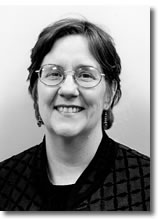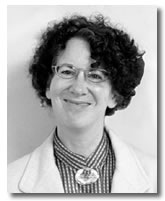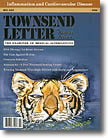True North Health Center
Practices Upstream Medicine
When you walk in the door at True North Health Center, in Falmouth,
Maine, you enter a large room with a skylight, a number of trees, and
a waterfall. With 7,500 square feet, the facility has room for ten
exam and treatment rooms, a patient resource area with high-speed internet
access, and two conference rooms for classes and workshops. It has
a 700 square-foot "teaching kitchen" where a natural
foods chef demonstrates healthy, tasty cooking during regularly scheduled
weekend workshops.
 But the most important thing that draws people to this integrative
health center is the way they focus on their patients. "Our
practitioners spend about an hour and a half with new patients, and
as long as they need with follow-up visits. That allows us to go into
some depth with people, hear their full story and build a relationship
with them," says Bethany Hays, MD, medical director. But the most important thing that draws people to this integrative
health center is the way they focus on their patients. "Our
practitioners spend about an hour and a half with new patients, and
as long as they need with follow-up visits. That allows us to go into
some depth with people, hear their full story and build a relationship
with them," says Bethany Hays, MD, medical director.
Some people seek out this clinic because they are coping with a difficult
health problem, haven't found solutions, and hope that True
North can help them. Others are healthy people who want to take charge
of their health so they can continue to be healthy. "Many people
who come here have been specialist-cared-for-to-death," Hays
says. "They've seen the rheumatologist and the gastroenterologist
and the dermatologist and their family doctor, and while they may have
a sense that all of their problems are tied together, none of their
doctors have had the opportunity to see the whole picture." Hays
herself practices functional medicine, which means she looks at problems
not as isolated symptoms, but as aspects of body systems. "I
look at whether the majority of symptoms relate to nutrition, or stress,
or the gastrointestinal system, or an inflammatory response. I ask
each patient, 'if you had a magic wand and could get rid of three
symptoms, which would you choose?' Then I make sure we focus
on those three symptoms."
Hays uses functional medicine to give patients a unified understanding
of why events in their life have led to these symptoms, and what can
be done about them. She calls this "upstream medicine." "Instead
of offering prescriptions and surgery to people as they go over a waterfall,
we go upstream and help them not fall in the river," she says.
The Complex Patient
Many of the patients who come to True North
have a complex presentation with several different symptoms, and that
makes it difficult to trace
the underlying cause of their problems. Hays recalls one woman who
had asthma, headaches, and chronic diarrhea. She was taking lots
of medications and had recently been hospitalized for pancreatitis.
Hays ordered lab tests, and while waiting for results asked the patient
to try a special diet, using a protein drink for breakfast and lunch,
and brown rice and steamed vegetables for dinner. "We gave
her a diet with good protein/carbohydrate balance, plus lots of vitamin
supplements, but very low in potential allergens. It's not
a dangerous fast, but it is a radical departure from the way most
people eat, and I wasn't sure she would do it. A week later,
she came back in and said, 'the pain I've had that goes
from my front to my back, the pain I've had for so long I
took it for granted, has gone away! Whatever you want me to do, I'm
here to do it!!"
An allergy test found that this patient was extremely sensitive to
a number of molds that are often found in foods, but also in the environment.
When she went on a strict diet her GI tract cleared up remarkably and
the pain and pancreatitis went away, but she was still having asthma
and headaches. She looked at the list of molds and said, "I
think this mold affects the building I work in." She took a
leave of absence from work, and within about six months all her health
problems resolved. Eventually she was able to convince the building
owners that it was dangerous, and they shut it down.
 To help other healthcare practitioners learn how to deal with patients
who have a constellation of several different conditions, True North
is holding its fourth annual integrative medicine conference this fall,
entitled "The Complex Patient: Biology, Relationships, and Healing." It
will be held October 19-22, 2005 at the Black Point Inn, an oceanfront
resort in Scarborough, Maine. It is approved for 20 CMEs. "Our
goal is to offer practitioners tools they can use with their most challenging
patients," says executive director Valeri Saffer. The conference
usually includes a mix of people. "We want to create a venue
where practitioners of different types can interact with each other
and explore new ideas in a non-judgmental way," adds Hays. "We
want to bring conventional and alternative practitioners together in
the same room, so they can explore each others' work with mutual
respect." Last year, about two hundred people attended the conference. To help other healthcare practitioners learn how to deal with patients
who have a constellation of several different conditions, True North
is holding its fourth annual integrative medicine conference this fall,
entitled "The Complex Patient: Biology, Relationships, and Healing." It
will be held October 19-22, 2005 at the Black Point Inn, an oceanfront
resort in Scarborough, Maine. It is approved for 20 CMEs. "Our
goal is to offer practitioners tools they can use with their most challenging
patients," says executive director Valeri Saffer. The conference
usually includes a mix of people. "We want to create a venue
where practitioners of different types can interact with each other
and explore new ideas in a non-judgmental way," adds Hays. "We
want to bring conventional and alternative practitioners together in
the same room, so they can explore each others' work with mutual
respect." Last year, about two hundred people attended the conference.
The Cost of Care
True North doesn't bill insurance. Patients pay out-of-pocket,
and receive reimbursement if their insurance companies cover out-of-network
providers. Typically, a new patient visit with a physician lasts 90
minutes (and costs $250) while a follow-up visit lasts an hour. Most
complementary sessions last an hour and cost $75. "We hope to
play a role in changing healthcare, and insurance gets in the way," explains
Saffer. "We're encouraging patients to think not just
about what their insurance will cover, but about what will really bring
them long-term, sustainable health."
However, for patients who cannot afford to pay cash for care, the clinic
has partnered with the New England Time Dollar Bank, an alternative
monetary system based on barter. "Members of the Time Dollar
Bank can barter an hour of their time for an hour of our time," explains
Hays. "This system isn't just located in Maine, it's
all over the world. What's really great about it, is the way
it builds community." The clinic also has a small fund from
private donors to cover services such as lab tests or supplements,
which can't be paid with Time Dollars.
With 17 providers and 10 administrative staffers, the clinic's
annual budget runs just below $1 million per year. They hope to reach
breakeven about two years from now. Meanwhile, they raised $30,000
last year in grants, and $500,000 from individual contributions. "We
have a full-time director of development, and we raise funds from donors
nationwide," Saffer says. "Why does someone from Oregon
or New York give to an integrative clinic on the Maine seacoast? Because
they want to help one clinic develop as a living model, and show that
this model of healthcare is truly possible."

Resources
True North Health Center: www.truenorthhealthcenter.org
For more information about the Integrative Medicine Conference, call
877-821-4488 or email conference@ truenorthhealth center.org
For more information about the Maine Time Dollar Network, www.mtdn.org

Elaine Zablocki is the editor of CHRF
News Files, a bimonthly emailed newsletter about the emerging
integrative medicine industry, published by the Collaboration for
Healthcare Renewal Foundation. |





 But the most important thing that draws people to this integrative
health center is the way they focus on their patients. "Our
practitioners spend about an hour and a half with new patients, and
as long as they need with follow-up visits. That allows us to go into
some depth with people, hear their full story and build a relationship
with them," says Bethany Hays, MD, medical director.
But the most important thing that draws people to this integrative
health center is the way they focus on their patients. "Our
practitioners spend about an hour and a half with new patients, and
as long as they need with follow-up visits. That allows us to go into
some depth with people, hear their full story and build a relationship
with them," says Bethany Hays, MD, medical director. To help other healthcare practitioners learn how to deal with patients
who have a constellation of several different conditions, True North
is holding its fourth annual integrative medicine conference this fall,
entitled "The Complex Patient: Biology, Relationships, and Healing." It
will be held October 19-22, 2005 at the Black Point Inn, an oceanfront
resort in Scarborough, Maine. It is approved for 20 CMEs. "Our
goal is to offer practitioners tools they can use with their most challenging
patients," says executive director Valeri Saffer. The conference
usually includes a mix of people. "We want to create a venue
where practitioners of different types can interact with each other
and explore new ideas in a non-judgmental way," adds Hays. "We
want to bring conventional and alternative practitioners together in
the same room, so they can explore each others' work with mutual
respect." Last year, about two hundred people attended the conference.
To help other healthcare practitioners learn how to deal with patients
who have a constellation of several different conditions, True North
is holding its fourth annual integrative medicine conference this fall,
entitled "The Complex Patient: Biology, Relationships, and Healing." It
will be held October 19-22, 2005 at the Black Point Inn, an oceanfront
resort in Scarborough, Maine. It is approved for 20 CMEs. "Our
goal is to offer practitioners tools they can use with their most challenging
patients," says executive director Valeri Saffer. The conference
usually includes a mix of people. "We want to create a venue
where practitioners of different types can interact with each other
and explore new ideas in a non-judgmental way," adds Hays. "We
want to bring conventional and alternative practitioners together in
the same room, so they can explore each others' work with mutual
respect." Last year, about two hundred people attended the conference.